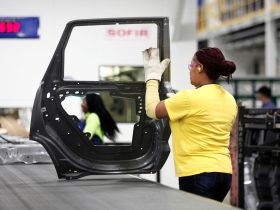You could call these past few months the summer of good vibes. People are working and spending, the economy has normalized, soaring inflation has moderated, and recession headwinds have faded.
Yet consumers’ overall confidence remains shaken. Sure, sentiment in August was up 39% from a historic low in June 2022, according to the University of Michigan’s U.S. index of consumer sentiment. But the index remained below prepandemic levels and, after seeing a few months of sharp increases, it has been moving sideways, hitting 69.5 in August, a small decline from July’s rate of 71.6.
Similarly, The Conference Board’s similar consumer confidence index missed expectations in August and fell to a reading of 106.1, down from 114 in July.
“Consumers perceive that the rapid improvements in the economy from the past three months have moderated, particularly with inflation, and they are tentative about the outlook ahead,” says Joanna Hsu, Surveys of Consumers Director.
The pullback in confidence has occurred as spending remains robust and the labor market strong. When sentiment falls, spending typically follows. But that hasn’t been the case: Americans are feeling and acting in contradictory ways.
“We’re in a particularly weird moment where consumers feel that their current finances are fine. So their current finances are supporting strong consumer spending. But they are particularly worried about the future,” macroeconomist Wendy Edelberg says.
Geopolitical events, employment levels, and economic strength all play into sentiment. Edelberg notes there is one indicator that’s even more closely inversely correlated: gas prices.
“I wasn’t terribly surprised when consumer sentiment was really low when gas prices were really high—it moves rather strongly with gasoline prices,” says Edelberg, director of The Hamilton Project and a senior fellow in Economic Studies at the Brookings Institution.
It’s true. When gas prices rose substantially over the past three decades, consumer sentiment consistently declined and vice versa. For example, consumer sentiment dived to its lowest point in June 2008 when gas prices swung up. That reading was even lower than the collapse of Lehman Brothers in September 2008.
Conversely, when Michigan’s consumer sentiment index registered a nine-month high of 101 in February 2020, gas was $2.44 a gallon, according to the U.S. Energy Information Administration.
Given that more than nine in 10 Americans have access to at least one vehicle, gas prices tend to be an acute issue for most households. And one that people can easily track given the giant price signs at every corner gas station.
So it shouldn’t be a surprise that when gas prices hit their high of $4.93 following Russia’s invasion of Ukraine, the consumer sentiment index recorded a historic low in June 2022.
While prices at the pump have fallen from those highs, they’re still above prepandemic levels. In fact, Americans haven’t seen average prices fall below $3.20 since that 2022 high mark. That means the average consumer is paying at least 32% more to fill up their car than they did when the pandemic started.
Gas prices are still far from leveling off given the continuing hurricane season and have started to climb again. The average cost of $3.84 hit at the end of August is on track to be the second-highest price on record for this time of year since at least 2004, according to Bespoke Investment Group.
“Consumers were once again preoccupied with rising prices in general [in August], and for groceries and gasoline in particular,” said Dana Peterson, chief economist at The Conference Board.
So until the pinch at the pump hurts less, consumer confidence will stay low even if the broader economy is humming along.
Write to editors@barrons.com
Read the full article here










Leave a Reply